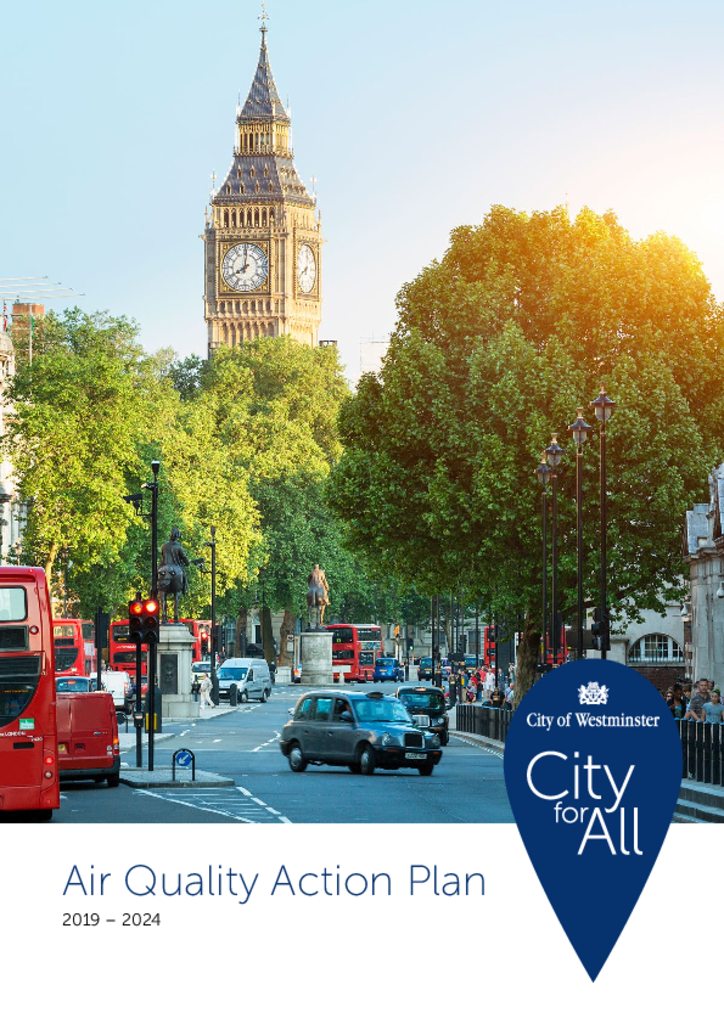Section B - air quality
Air pollutants have both natural and manmade sources. Released into the atmosphere, they can have a devastating impact on people, on the fabric of buildings and on biodiversity. In Westminster, the key pollutants we are focused on addressing are Nitrogen Dioxide (NO₂), a toxic gas, and Particulate Matters (PM), which are tiny airborne particles made up from a number of different materials. Pollution in the city can be influenced by meteorological conditions, and by pollution originating from outside of Westminster. However, we still have the potential to control the majority of pollution that is caused by our activities and actions. The biggest sources of emissions in our city arise from gas boilers used to heat and power buildings and from emissions from vehicles.
Actions from developers can play a key role in reducing air pollution in the city. This includes integrating mitigation measures into building design, avoiding installing combustion sources by focusing on electric only development and where combustion sources are proposed ensuring that they are low emission gas boilers as a minimum. Westminster’s policies on air quality aim to support developers in reducing the air quality impacts of new development, from design to construction phases and into the operational use of the built environment.
It is important to note that carbon dioxide (CO₂) is not considered to be an air pollutant. However, reducing carbon emissions and actions to improve air quality, have some of the same beneficial effects on the environment and they are both priorities for us.
Our approach
Westminster has been at the forefront of research and interventions to improve air quality in London for decades. Over the past years, air pollutant levels in the city have improved due to interventions including:
- Don’t Be Idle – our award winning behaviour change campaign to encourage drivers to turn off their engines when stationary.
- Schools Clean Air Fund – auditing schools to identify interventions which will mitigate the impact of poor air quality, and funding appropriate interventions.
- Marylebone Low Emission Neighbourhood (LEN) – a neighbourhood-based scheme that reduced the dominance of vehicle traffic through a range of green infrastructure, public realm improvement and behaviour change interventions and by piloting the city-wide diesel surcharge.
Our 2018 Air Quality Manifesto sets out ten air quality pledges to:
- reduce or clean up dirty journeys
- ask people that have more than one vehicle to pay extra for their parking permits unless they are driving low emission vehicles
- invest in more ways to encourage the use of electric vehicles in the city
- go further in tackling emissions from buildings
- create low emission zones around schools
- support residents to monitor air quality in their neighbourhoods
- increase recycling and reduce the use of resources
- Don’t Be Idle
- innovation and thought leadership
- lobby government
Following on from this we published our Air Quality Action Plan. Part 1 sets out the context incorporating the council’s statutory requirements as an Air Quality Management Area. It establishes the links between air pollution and a range of the council activities, policies and strategies, including,
- sustainable transport
- Public Health; and
- climate emergency
The second part of the plan is the Action Plan which consists of 88 individual actions that the council will undertake to support air quality improvement.
The themes and actions in the Action Plan have been incorporated in the latest version of City for All and embedded in our activities across directorates.
More information
Air Quality Action Plan 2019 – 2024
Additional guidance we recommend developers use to undertake Air Quality Assessments and impact assessments:
IAQM and EPUK 2017 Land use Planning and Development Control: Planning for Air Quality
London Councils’ Air Quality and Planning Guidance
The Control of Dust and Emissions During Construction and Demolition SPG
Additional advice
For informal advice on air quality issues related to planning applications contact: [email protected]
For formal pre-application advice please visit our pre-application advice website
For queries related to the council’s air quality policies contact: [email protected]
Air Quality Neutral and Air Quality Positive
An air quality neutral development is defined by the GLA as having a likely ‘acceptable’ impact on local air quality. However, this is not always the case and developers are encouraged to take all actions they can to reduce adverse impacts to local air quality. The London Plan introduces the ‘air quality positive approach’ where developments have a positive approach on the air quality in a neighbourhood or specific site. Both of these concepts relate to completed development and supplement the assessments that are required for the construction phase.
The Mayor has just published a pre-consultation document that provides further guidance and advice on achieving air quality neutral and air quality positive standards which can be found at london.gov.uk.

